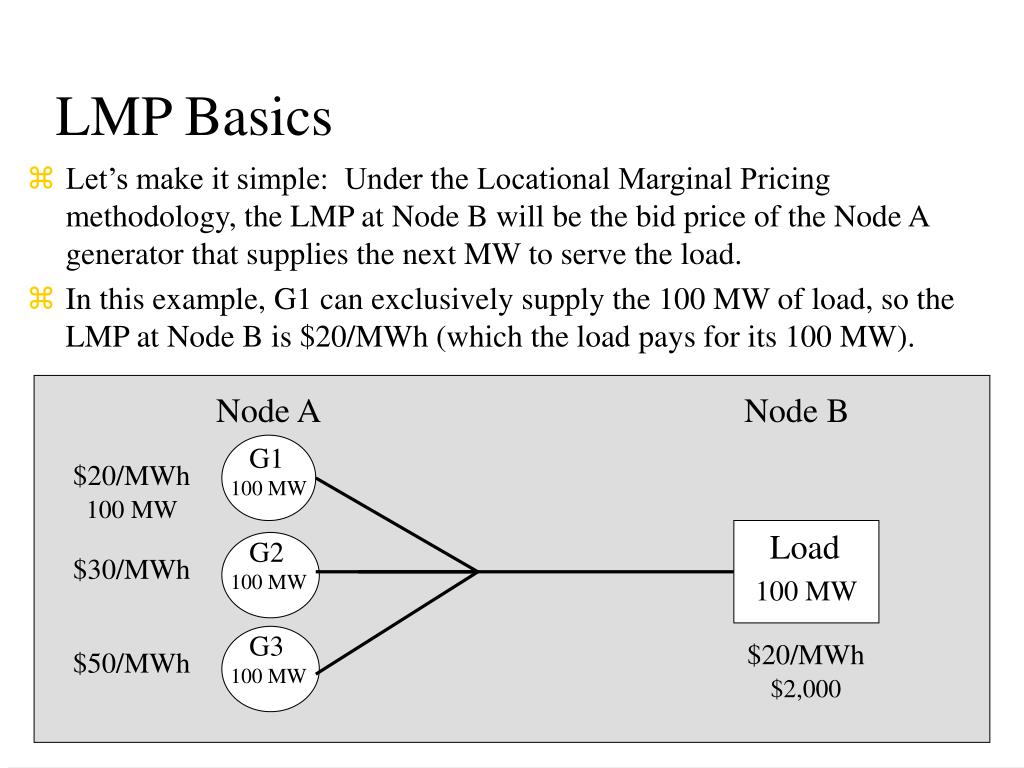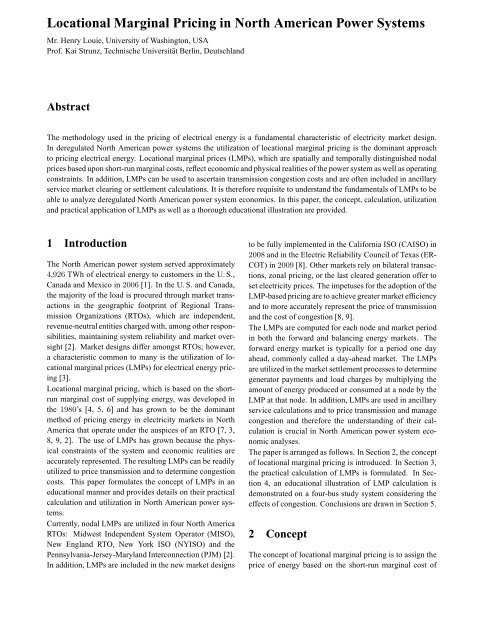Locational Marginal Price
“Locational Marginal Pricing” is a one-day interactive seminar that explains nodal pricing in electric power markets for legal, regulatory, and accounting professionals.

Locational Marginal Price 1. Introduction to Locational Marginal Price (LMP) 전력산업에서 경쟁적인 환경을 가지고 있는 미국에서는 2002년 Federal Energy Regulatory Commission (FERC)의 제안에 따라 Independent System Operator (ISO)들이 Locational Marginal Price (LMP)를 적용하기 시작했다. What is Locational Marginal Pricing (LMP)? LMP stands for Locational Marginal Pricing and represents the cost to buy and sell power at different locations within wholesale electricity markets, usually called Independent System Operators (ISOs). Examples of ISOs include PJM, ISONE, MISO, CAISO, and NYISO.
You learn the basics of:
- marginal clearing prices in an offer-based economic dispatch market
- transmission constraints
- hedging of energy and transmission price variation
- market power
(For a technical overview of Locational Marginal Pricing, read the syllabus for my UT grad course.)
“You made a very complicated subject much easier to analyze and understand. A great course!”
Prerequisites: General knowledge of electricity markets. No math or technical prerequisites.
Format: Seven lecture hours illustrated with 200 slides. Interactive exercises.
Documentation: You receive a three-ring binder of the entire seminar plus a cross-referenced glossary of terms.
Customization: This seminar can be presented on-site at your company.
Instructor: Dr. Ross Baldick, Professor of Electrical and Computer Engineering at The University of Texas at Austin.
Questions? Email Dr. Baldick
“Locational Marginal Pricing” has been presented at:
- ERCOT
- Dynegy
- Austin Energy
- Lower Colorado River Authority (LCRA)
“One of the best professional educational seminars I have attended. Dr. Baldick builds on concepts from the ground up, in a clear and comprehensible manner. He engages attendees in discussion and responds thoughtfully to all questions.”
Questions? Email Dr. Baldick
Curriculum:
1. Offer-based economic dispatch
- Block prices for energy offers
- Demand and demand bids
- Dispatch and pricing
- Two generator example
- Three generator example
- Incentives from pricing rule
- Variations
Locational Marginal Price Caiso
2. Hedging energy price risk
- Financial versus physical bilaterals
- Contracts for differences to hedge price variation
3. Transmission
- Transmission constraints
- One line example
- Three generator, four line example
- Locational marginal pricing (LMP)
- Congestion rental and congestion cost
- Properties of LMPs
- Commercial network model
- Losses
4. Hedging transmission price risk

- Variation of LMPs
- Financial Transmission Rights (FTRs)
- One line example
- In combination with CfDs
- Acquiring FTRs
- Revenue adequacy
- Flowgate rights
- Option FTRs
5. Conclusion
- Virtual bidding
- Market power
- Market power mitigation
Questions? Email Dr. Baldick
by Bob Shively, Enerdynamics President and Lead Instructor
A number of years ago, I was teaching our Electric Market Dynamics course in New York City when a developer new to the power plant business described a project he was going to finance in western New York. He had just finished his first project in Long Island, which worked out well, and asked me: “Should I be concerned about locational marginal pricing?” My response was emphatically YES.
As shown by the graph below, prices in western New York are significantly different from prices on Long Island, meaning that unit revenues for his new project would be significantly lower than his experience on Long Island might suggest.
Average Wholesale Electricity Prices for July 2013:
Source: NYISO July 2013 Monthly Report
For readers not already familiar with locational marginal prices, or LMP as it is more commonly called, LMP is “the marginal cost of supplying, at least cost, the next increment of electric demand at a specific location (node) on the electric power network, taking into account both supply (generation/import) bids and demand (load/export) offers and the physical aspects of the transmission system including transmission and other operational constraints.”[1] LMPs vary hourly depending on the factors described above and can vary widely between different locations. According to economists, they send the right price signal to generators and consumers, telling them exactly when and where power is cheap or expensive.
Of course the developer who took my class has now learned, like other generators, to study LMP intensively as the LMPs at their plant directly impact the unit’s revenues. But we still find that many consumers of electricity are in the dark about the concept of LMP and are not familiar with whether or not locational prices impact them. Consumers that are served by utilities are usually blind to LMPs because utilities average power supply prices across their territory, so consumers in high LMP areas are charged the same price as consumers in low LMP areas. This eliminates the benefit of sending consumers accurate price signals, but avoids having to address the historical regulatory concept of non-discriminatory treatment (one could argue, that it is not discriminatory to charge consumers a higher price in a higher LMP area since the cost of service is higher there, but politicians and regulators have not yet been willing to go down that road).
In regions with competitive retail markets, we are starting to see LMP functioning as envisioned for the consumer side of the business. An example is West Texas. West Texas has seen significant load growth in recent years with growth of oil drilling and production but has not seen significant growth in transmission or generation:
Pjm Locational Marginal Pricing
Source: ERCOT Report on Existing and Potential Electric System Constraints and NeedsDecember 2012[2]
The result is rapidly escalating power prices for consumers[3] in some cases even if they had contracted for a “fixed” rate[4]. What is the result of this? Consumer pain for sure which doesn’t sound positive. But also rather urgent efforts to alleviate the problem including use of demand response[5] and transmission construction[6]. It will be interesting to see whether the market can indeed respond to the West Texas prices. If so, it will speak well to the benefits of transparent prices in competitive markets. If not, there will pressure to go back to regulatory solutions.
[1] Definition is by the California ISO, taken from the presentation “Locational Marginal Pricing (LMP): Basics of Nodal Price Calculation” available here: http://www.caiso.com/docs/2004/02/13/200402131607358643.pdf
[2] Available at http://www.ercot.com/content/news/presentations/2013/2012%20Constraints%20and%20Needs%20Report.pdf
[3] See for instance: Electricity Prices Soar as in West Texas as Shale Drilling Expands available at http://fuelfix.com/blog/2013/06/26/west-texas-power-demand-surging-as-shale-drilling-booms/ and At Center of Oil Boom, Electricity Costs Soars available at: http://online.wsj.com/article/SB10001424127887324694904578601793013694354.html
[4] How can a fixed rate increase? Many contracts are written to pass through congestion costs to consumers even though the remainder of their rate is fixed (congestion costs are usually the main reason for large LMPs differences between regions).
[5] See West Texas Electricity Prices Skyrocket – Demand Response is the Answer available at http://blogs.edf.org/texascleanairmatters/2013/07/31/west-texas-electricity-prices-skyrocket-demand-response-is-the-answer/

Pjm Historical Lmp Prices
[6] See ERCOT transmission studies identify upcoming transmission projects and potential long-term needs available at http://www.ercot.com/news/press_releases/show/26375